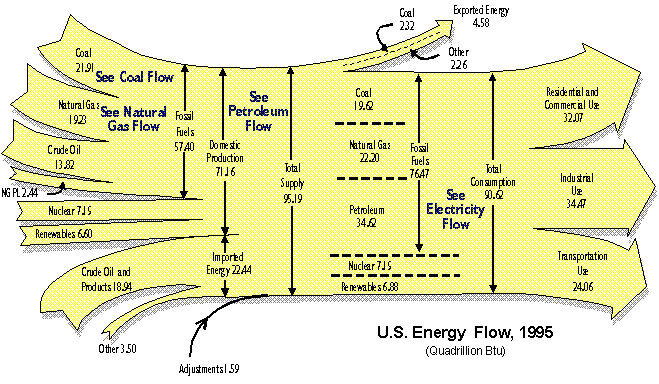
Environmental Geology
Fossil fuels
Lecture Outline
Announcements
Energy: the capacity to do work.
Human's success as a species is largely because of their ingenuity in exploiting energy in myriads of ways.
In 1990, non-renewables (fossil fuels) provided 90% of global energy. 92% in US. Global economy heavily invested in use of non-renewable resource.
FIGURE 1: 1994 US Energy Sources and Uses: FROM US Department of Energy

Look at figure and notice renewable energy source contribution. Hydropower and wood burning contribute 90% of renewable power. Wind, geothermal, and solar power thus contribute only about 1% of US energy needs at present.
Question: how long before the resource is exhausted and what then?
I. Supply, demand, and reserves: Terminology and concepts
Reserves - already discovered deposits that can be extracted profitably.
Sub-economic or conditional resource - already discovered deposits that cannot be extracted profitably at present price.
Inferred resource - deposits that are likely to exist, but haven't yet been discovered. Can be estimated via statistical means.
Resource price increases or production cost decreases typically lead to increase in reserves because some previously discovered low concentration deposits become profitable.
Increase in commodity price often drives people to conserve, recycle, or use substitutes. Reserves may thus not always increase as prices increase.
II. Energy Use
Energy sources can be divided into two categories.
Renewable energy - provided by resources that accumulate as quickly or more quickly than they are used. Examples: sunlight, hydroelectric.
Non-renewable energy: Provided by resources that do not accumulate as quickly as they are used. Use is not sustainable over long run. Examples: oil, gas, coal, nuclear.
Principal energy use concentrated in generation of electricity (13% globally), generation of heat, and transportation.
III. Fossil fuels : Definition, formation, and accumulation
Fossil fuels - fuels derived from the remains of dead organisms. Examples include coal, oil, oil shales, tar sands, natural gas, and peat.
Hydrocarbons are molecules that incorporate both carbon and hydrogen. When hydrocarbon molecules are exposed to heat, the bonds linking the carbon and hydrogen atoms break. The liberated hydrogen combines with nearby oxygen to form water; the liberated carbon combines with oxygen to form carbon dioxide, and the net energy released by these chemical reactions is positive.
Overhead 1 - Time line of fossil fuel use
Formation of fossil fuels
Fossil fuels form only under exceptional circumstances. Dead organisms remains normally dry out (i.e. dehydrate) quickly, leaving behind their organic content (i.e. molecules that contain carbon). Normally, oxygen reacts with the organic matter, causing it to oxidize and re-enter environment as carbon dioxide or other carbon-based molecules. However, if organic matter is buried quickly enough or is introduced into an oxygen-poor environment such as lake-bottom water that lacks oxygen, the energy content locked into the hydrocarbon molecules is preserved, and can be released if burned in an oxygen-rich environment.
Oil and Natural Gas (methane) are fossil fuels formed through the accumulation and transformation of the remains of small marine organisms into liquid hydrocarbons. The necessary conditions for the formation of recoverable oil and gas deposits are
Conditions necessary to for form oil and natural gas
Study figure of petroleum traps in Pipkin, Page 339
Coal and Peat - fossil fuels formed through the accumulation and transformation of land-based organisms. Details given on page 346 of text.
Tar sands and oil shales - discussed in text. Total energy resource represented by these fossil fuels is astoundingly large, equivalent to several hundred years supply. Not presently economical because of technological and environmental impediments.
Presently supplies more energy to global economy than any other fuel. Roughly 25-30%.
Abundant, cheap supplies of oil may continue for 20 to 50 more years, although significant supplies of oil will certainly be available for longer than that for the right price.
Interesting facts:
Natural Gas or methane - The fossil fuel of the next 50-100 years.
Lifetime of total resource in U.S. at present use rates is about 65 years. USGS estimates it will require about 1 million new gas wells to pump out the resource.
Why is this the fossil fuel of the future?
At present trends, natural gas will overtake oil in the next 10-12 years as the number one globally produced fossil fuel.
Reserves are so abundant in some countries that they are simply flared off and lost. However, globally, an enormous gas rush is on - many tens of billions of dollars of natural gas pipelines and power plants are being built each year to exploit this abundant and relatively clean fuel.
Disadvantage: Methane is a powerful greenhouse gas, so when it escapes during pumping, transport, or use, it contributes to our greenhouse effect. Its also extremely explosive.
Coal is our most abundant and yet dirtiest source of fossil fuels. For current or slowly increasing levels of energy use, proven recoverable reserves in U.S. are sufficient to supply all of our energy needs for about 260 years. Globally, we have a 230 year supply of coal.
In the U.S., coal generates 56% of the electricity, and globally, coal generates 44% of electricity.
Advantages:
Disadvantages:
V. Energy Efficiency and Conservation (click here for energy efficiency info)
Ways to extend fossil fuel reserves or reduce our dependence.
Increased efficiency goes hand in hand with conservation.
Examples: Superefficient Cars, more efficient electrical appliances, better energy-to-power conversion efficiences
Amount of energy to be saved is enormous - energy saved by high-efficiency light-bulbs, if installed for old incandescent types, would equal entire power output of nation's 109 functioning nuclear power plants. Installing variable speed motors in US factories would save more than $100 billion per year in industry power costs . Savings in power costs would pay back for the cost of the new motors in less than 1 year!